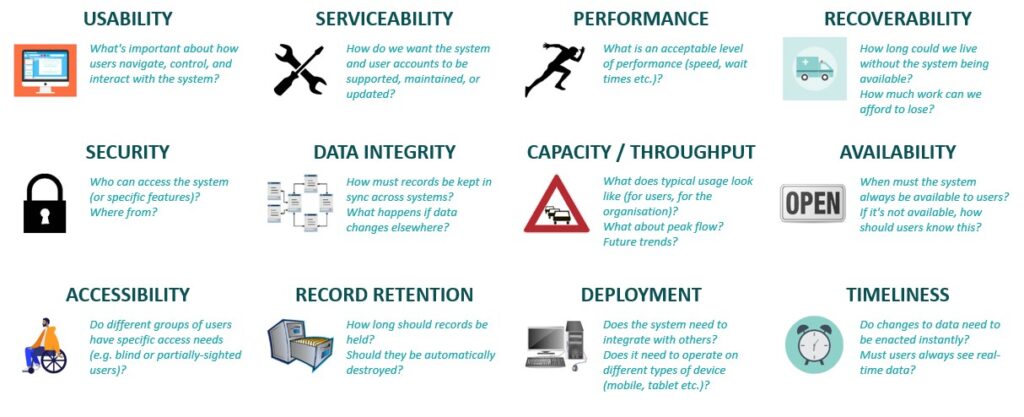A central element of a business analyst’s role is to help the organisation in evaluating options to choose the “best” solutions – those that most effectively meet its needs, provide the best return on investment, or come with the most certainty. Depending on your organisation’s size, maturity, and risk appetite, this process can be light-touch and informal, or deep, comprehensive, and extensively scrutinised. All too often, weighing options comes down to some number crunching to determine Return On Investment (ROI), but this approach can be blinkered and lead to unforeseen or perverse outcomes. Adopting a more holistic approach to evaluating options leads to more appropriate solutions, unlocking value,

In order to reveal the “best” options, the business analyst needs to consider a wide range of factors and perspectives, analysing and synthesising this information to recommend the “best” options. In this post, I’ll look at the things a BA can examine to make a holistic – and better informed – assessment of feasibility and comparison of options.
I’ve not attempted to prescribe a particular format or series of steps; instead, I’ve opted to present a range of questions a BA can ask when evaluating options. I’ve broken these down into those that examine a “new world” where this options has been chosen, and questions that consider the “journey” that the organisation would need to take to get there. It’s also important to consider “doing nothing” as an option. You can decide how deep or “scientific” you analysis needs to be for the scale and importance of the decision to be made.
Feasibility in the new world
Imagining a future where this option has been chosen and successfully implemented can help you assess its appropriateness.
The following questions seek to evaluate how well this option addresses the business needs, its strategic and cultural fit, how it’s likely to be received, the benefits it brings, and the ongoing cost implications.
To what extent does this option meet our needs?
Perhaps the most important question of all is whether this option does what we need it to.
If you’re looking at different tech solutions, consider both the functional and non-functional requirements that have been identified. You may have already identified functions, use cases, or user stories – will these features be present? What about aspects such as security, performance, accessibility?

Think about whether this option is compatible with what’s already in place? Will it work well with existing processes or technology? Is picking this option going to create the need for temporary (or ongoing!) workarounds?
What else now has to change?
Do we have the resource, skills, and competencies to use this solution once we’ve got it? If not, can we obtain or develop them? How quickly can we start getting value from this solution?
Who is going to support or maintain the solution? What if things go wrong?
Does this option support the wider mission?
Strategic fit is key. Any change or solution without a demonstrable link to the organisation’s wider goals should probably be disregarded! However, piecing together the organisation’s strategy can be challenging, particularly if you don’t have access to senior leaders or if the strategic goals are a bit woolly or poorly-articulated.
Piece together any information you can lay your hands on that give clues about strategic intent – this might include statements from executives on the company website, objectives, or KPI targets. Use this information to infer desired outcomes, and show how this option aligns to these – putting this in front of decision-makers will often lead to valuable discussion and new insights.
Does this fit with our culture and values?
Consider what kind of culture exists in the organisation. Would this option fit well in this culture. If not, could this create problems? Might it promote a positive change?
If the organisation has published statements about the values it wants to promote, look at how this option aligns against those, and put this in front of decision-makers. This can be particularly important if you’re sensing a mismatch between what the organisation says and what it ends up doing. And of course, if you don’t think an option is ethical, call this out!
How does it affect our future finances?
Putting aside the costs of implementing this option (more on that later), it’s worth examining how ongoing costs would look once this option is in place.
Are there new or increased costs we’ll be incurring from now on (licences, support fees etc)?
Do some things get cheaper or more expensive? Does this option negate the need to spend money on something else?
Does it affect how others see us?
Does this affect how we’re perceived by our people, our customers, our shareholders, or our competitors? What’s the likely effect on our brand? Will pursuing this option generate media attention – and will that be favourable?
Impact mapping, personas, and use of “stop/start/continue” can help reveal how groups of stakeholders will be affected in different ways, which in turn helps reveal how they might perceive changes.

Is it what people want?
Will it be popular – and if so, who with? Do our people or customers prefer another option? It’s not unknown for a senior stakeholder to push very strongly for a particular option. While it may not be appropriate to call out their support, asking more questions to establish why they want this can be very revealing.
You’ll likely have already undertaken some stakeholder analysis, so use this information – and anything else you can glean through interviews, surveys, etc. – to understand how they’re likely to view this option.
Will it bring the benefits we’re hoping for?
Be clear about the benefits this option should bring about – whether that’s tangible value (e.g. cost savings) or intangible (e.g. quality of life). What benefits will we really achieve if we choose this option? Benefits mapping can help articulate this.
Think about how quickly can the organisation can expect the benefits to emerge? How will we know we’re achieving them? Who will be looking?
Encourage honest about how likely achieving these benefits really is, and how confident we are in our estimates.
The journey to get there
Solutions don’t tend to magically implement themselves – instead, organisations must devote time, money, and other resources to make the change happen. Understanding the journey to putting a solution in place – and the implications of this – is an important element when evaluating options.
The following questions seek to establish the feasibility of implementing this option, whether this is the right time, and what trade-offs might be required to make this happen.
Can we get there?
Have we got the time and resources to implement this? If not, can we secure them? How risky is the journey to put this solution in place? Why is this option easier or more difficult for us to pursue?
Talking to project managers, technical teams, or others that might be involved in implementing this solution can help provide estimates of likely time and resource requirements. They can also advise on whether this option would come with particular risks or challenges that might make it harder or more time-consuming to implement.
Can we afford it?
Every option is likely to present a unique cost profile to deliver. This can include procurement costs (e.g. purchasing technology), and implementation expenses (such as project resources and materials).
As well as knowing what a given option is likely to cost, you’ll need to establish how affordable this is for the organisation. Are the financial resource readily available? If not, is borrowing an option? Can our cashflow absorb this?
Some in-depth number crunching can be useful here, and you may want to seek advice from Finance teams if techniques such as calculating Net Present Value make your head spin!

Is now the right time?
Is this the right time? What else do we have going on? Do we have the bandwidth right now? What’s changing externally that might affect when we choose to pursue this option? Is borrowing likely to get more expensive in the future? Is competition for resources growing?
It’s possible that less attractive solutions may be the best option at the current time, or that waiting to make a change could be worthwhile.
What opportunity costs arise from pursuing this option?
Time and money allocated to pursuing this option may mean that other changes can’t happen – and therefore the benefits of those changes won’t be achieved. While this particular initiative may prove a roaring success, is there a chance it might prevent bigger wins elsewhere?
Talking to business leaders in the organisation and to those involved in other change initiatives can help uncover important insights about the wider change agenda. You may not be privy to everything that’s going on, but you can definitely pose questions to get others thinking!
What if we don’t do this?
It’s important when evaluating options to consider the advantages and disadvantages or not pursuing this option, and of not pursuing any option at all. You need to be able to show the implications of not taking any action – and sometimes this may be the best route!
You can show the likely effects of maintaining the status quo – whether that’s failing to dodge a looming threat, or not seizing a fleeting opportunity for the organisation. You can assess the costs, benefits, and practical effects of inaction.
Consider whether the current situation is sustainable – will problems just get worse over time costing the organisation more? Perhaps the organisation can live with things as they are, but will its customers persevere or begin to look elsewhere?
While “doing nothing” may mean not buying a new tech system, or not changing a business process – and saving on the effort and expenditure of doing so – inaction may create other problems that need time and money to tackle.
Supporting decision-makers in evaluating options
Business analysts rarely get to make decisions themselves (probably for the best!) and are instead tasked with presenting options and making recommendations for other stakeholders to decide on. I’ve not attempted to lay out a template for presenting options, as many organisations will already have such artefacts in place (and with varying degrees of flexibility around them!).
Instead, I recommend thinking about how you would best present the holistic view you’ve established to those that will make choices. Regardless of whether you can (or want to) bake everything into a single document, there are other means available:
Conversations – talking to decision-makers as you conduct your investigations and analysis means they are not coming at the decision cold. You can share what you discover in advance of the moment of choosing, and get insights on their preferences and reasoning.
Presentations and stories – laying out information in a lengthy document might tick a governance and diligence box, but telling stories brings things to life, encourages deeper engagement, and provokes ideas and challenge.
Images – can pictures, graphs, charts, or diagrams help convey abstract ideas, connect the dots, or simplify the issue?
Tailor your approaches based on what you know about the decision-makers. Think about what will help them understand the big picture and reach the best decisions when evaluating options.